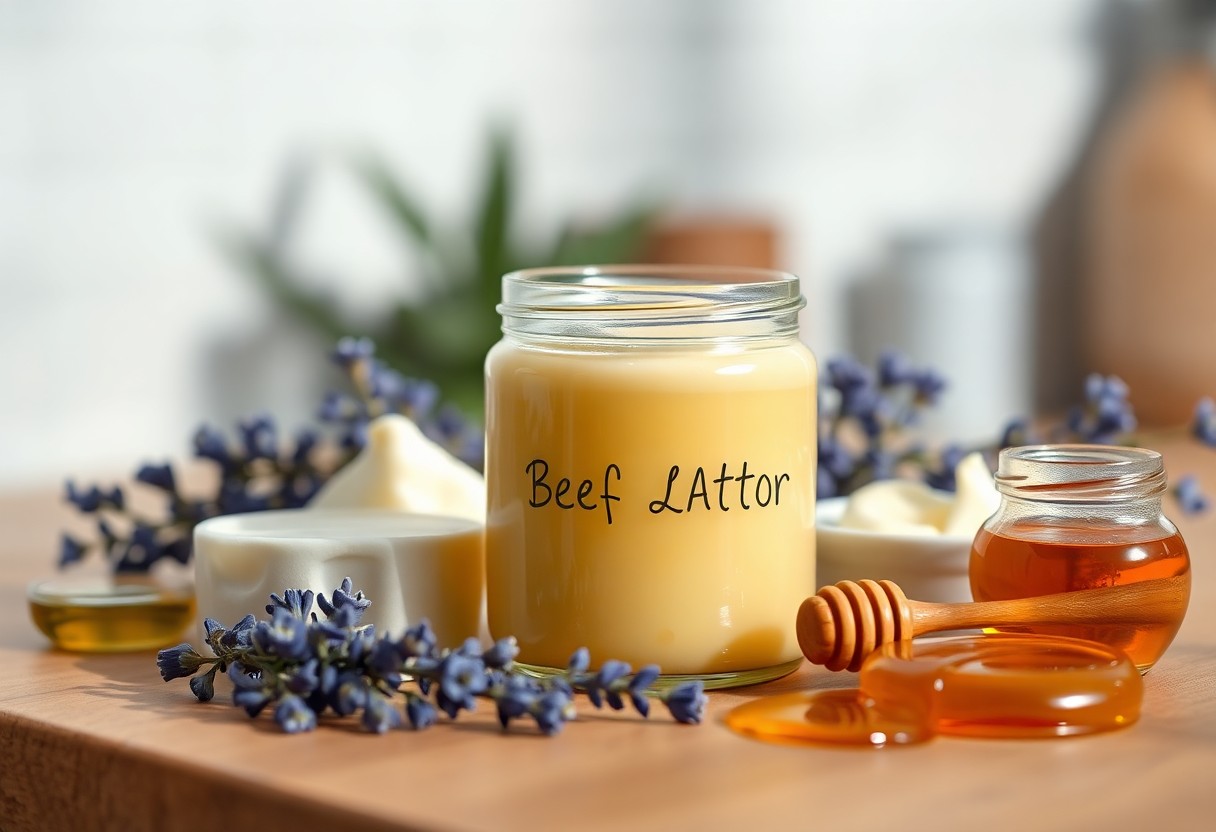Beef tallow has emerged as a trending ingredient in the skincare community, leaving many curious about its potential benefits for your skin. This natural fat, rich in nutrients, is claimed to moisturize and nourish, but you should be aware of both its advantages and risks. As you examine into this topic, it’s crucial to evaluate whether beef tallow is a suitable addition to your daily regimen or if you should stick with more conventional products for your skin care needs.
The Rise of Beef Tallow in Skincare
For many, incorporating beef tallow into your skincare routine may seem unconventional, but its popularity has surged in recent months. Spursed by various social media platforms, the trend claims to simplify skincare regimens, appealing to those overwhelmed by multiple product layers. With hashtags like #beeftallow amassing thousands of posts, this age-old substance has caught the attention of a younger audience eager to embrace natural alternatives in their quest for healthier skin.
Social Media Influence
To many users, TikTok has become a breeding ground for beauty trends, with influencers passionately promoting beef tallow as a more straightforward solution for your skincare needs. With millions of views on related content, creators tout personal success stories, claiming improvements in skin condition while following a minimalistic approach. This overwhelming digital presence has undeniably sparked curiosity and diverted attention from traditional products.
The Appeal of Simplicity
By streamlining your skincare routine, beef tallow appeals to those who seek efficiency without compromising their goals for healthy skin. The claims that beef tallow mimics your body’s natural oils resonate strongly with individuals battling complicated regimens filled with synthetic ingredients. Many are excited by the prospect of nourishing their skin with a single product, with creators noting significant improvements in texture, hydration, and clarity.
Social media has effectively catalyzed this trend, tempting you with the idea that you can simplify your routine while achieving impressive results. The notion of ditching multiple products for one versatile solution not only saves time but also addresses concerns over ingredient overload. As a result, many are drawn to this nostalgic method touted as an effective way to restore your skin’s natural balance and vitality.
Nutritional Composition of Beef Tallow
Any discussion on beef tallow for skincare emphasizes its unique nutritional profile, contributing to its popularity among skincare enthusiasts. Derived primarily from the fat of cattle, beef tallow contains various important nutrients that may benefit your skin’s health. However, it’s important to weigh these advantages against potential risks and compare them to standard skincare products.
Vitamins and Fatty Acids
Nutritional analysis reveals that beef tallow is rich in vitamins A, D, E, and K, alongside omega-3 and omega-6 fatty acids. These components are thought to provide hydration and protective benefits for your skin, aligning with some claims from its proponents.
Comparison to Conventional Moisturizers
By evaluating beef tallow against conventional moisturizers, you can better understand their differences. While beef tallow offers a natural emollient effect, typical moisturizers often contain well-studied ingredients optimized for skin absorption and efficacy.
Comparison to Conventional Moisturizers
| Beef Tallow | Conventional Moisturizers |
| Contains saturated fats and cholesterol | Formulated with various hydrating ingredients |
| Rich in certain vitamins | Often contains antioxidants and peptides |
| Non-regulated as a skincare product | Subject to FDA regulations ensuring safety |
Vitamins and fatty acids found in beef tallow can pose both benefits and challenges. While the rich vitamin content is appealing, it does not necessarily translate into better overall performance when compared to commercial moisturizers, which are designed to optimize absorption and skin compatibility for overall skin health.
Benefits and Drawbacks of Moisturizers
| Benefits | Drawbacks |
| Formulated for specific skin types | May include synthetic ingredients |
| Clinically tested for effectiveness | Could cause sensitivity in some individuals |
| Non-comedogenic options available | Higher cost for premium products |

Dermatologists’ Perspectives
It is crucial to consider dermatologists’ viewpoints regarding the rise of beef tallow in skincare routines. While some TikTok users advocate for its use, reputable dermatologists raise concerns about the safety and effectiveness of applying animal fat directly to your skin. They emphasize the importance of ingredients that have a well-documented history of safety and efficacy over novel trends that lack scientific backing.
Potential Benefits
By examining the nutrient profile of beef tallow, you may find that it contains vitamins A, E, D, and K, along with omega-3 and omega-6 fatty acids. Some dermatologists note that its emollient properties can soften rough skin and provide hydration benefits, making it an interesting, albeit unconventional, alternative to traditional moisturizers.
Risks and Concerns
An important aspect to consider is the potential risks associated with using beef tallow for your skincare routine. Since it is not regulated as a skincare product by the FDA, there may be concerns about contamination or allergenic reactions that could arise from its use.
It is vital to understand that using beef tallow directly from the grocery store poses risks to your skin, including the possibility of clogged pores or unwanted irritation. Experts suggest opting for beef tallow formulations specifically designed for skincare, highlighting that the term “non-comedogenic” may not guarantee safety, as it is not FDA regulated. Traditional products like petrolatum may offer better occlusive properties for preventing moisture loss without the risks that beef tallow could introduce.
Beef Tallow vs. Retinol
To compare beef tallow and retinol, it’s crucial to understand their distinct roles in skincare. While beef tallow acts primarily as a moisturizer by providing emollient benefits, retinol penetrates deeper into the layers of your skin to combat free radicals and promote cellular turnover. Experts highlight that retinol’s unique benefits far exceed the moisturizing properties of beef tallow, making it a more effective choice for those seeking to improve their skin’s health and appearance.
Mechanisms of Action
By examining how these two substances work, you can appreciate their differences. Beef tallow contains saturated fats and vitamins that contribute to surface hydration, while retinol operates at a more profound level by stimulating collagen production and addressing signs of aging. This fundamental distinction impacts how each ingredient influences your skin over time.
Effectiveness in Skincare
Beside the differences in their mechanisms, beef tallow’s effectiveness in skincare is relatively limited when compared to retinol. While beef tallow does provide fatty acids and some vitamins beneficial for hydration, dermatologists agree that it does not deliver the same level of transformative results that retinol offers.
Due to its ability to promote cell turnover, reduce fine lines, and improve skin texture, retinol is a well-studied and proven option in skincare. In contrast, beef tallow, while it may offer temporary moisture, lacks sufficient evidence to support long-term benefits for your skin. Therefore, integrating retinol into your skincare routine could yield more substantial improvements than relying on the increasingly popular beef tallow approach.

Recommendations for Use
All users considering beef tallow for their skincare regime should start with a patch test to assess any allergic reactions. Look for products specifically formulated for skincare rather than using cooking tallow from the grocery store to minimize contamination and ensure effectiveness. Always apply a small amount to clean skin, observing any reactions before incorporating it into your routine fully.
Safe Application Practices
Above all, ensure your hands and the area of application are clean before using beef tallow. Apply the product in moderation to clean, dry skin, and avoid areas with breakouts unless you are using a product designed to be non-comedogenic.
Choosing Products Wisely
For your safety and maximum benefits, opt for beef tallow products labeled as “non-comedogenic” to prevent pore clogging. Check ingredients thoroughly, as not all beef tallow products are formulated equally. Products that prioritize quality over quantity will help you enjoy the potential emollient benefits without adverse effects on your skin.
Consequently, you should be discerning when selecting beef tallow products. Look for reputable brands that disclose their ingredient sourcing and manufacturing processes. Enhancing your understanding of the product can help you harness the benefits while avoiding potential irritants. Formulations enriched with additional skin-loving ingredients can also improve the overall efficacy for your skin health.
Alternative Natural Oils
Unlike beef tallow, there are various plant-based oils that can provide effective moisturizing and nourishing benefits for your skin. These oils have a long track record of safety and efficacy, often containing necessary nutrients and fatty acids that support overall skin health without the potential risks associated with animal fats.
Comparisons with Plant-Based Oils
Against the rising interest in beef tallow, consider the benefits of plant-based oils with the following comparisons:
Plant-Based Oils vs. Beef Tallow
| Feature | Plant-Based Oils |
| Sustainability | More environmentally friendly |
| Coatings | Less likely to clog pores |
| Nutritional Profile | Rich in omega fatty acids |
| Safety | Widely recognized and tested |
Popular Dermatologist-Recommended Oils
Oils that dermatologists frequently recommend include jojoba oil, argan oil, and squalane. These oils are celebrated for their ability to hydrate without the overly greasy feel of heavier products. They mimic your natural skin oils, making them great alternatives to beef tallow for moisturizing routines.
Alternative options like jojoba oil and argan oil are known for their lightweight texture and effective absorption into the skin, offering anti-inflammatory and soothing properties. Squalane, derived from olives, is another excellent choice that mimics the natural oils in your skin, promoting hydration and elasticity without leaving a heavy residue. Incorporating these oils can elevate your skincare routine with proven benefits and a safer profile than animal-derived products.
Conclusion
Summing up, while the trendy use of beef tallow for your skin care may appeal to you due to its perceived benefits and natural origins, dermatologists suggest a more cautious approach. The lack of regulation, potential contamination, and the existence of well-studied alternatives call for careful consideration. Before adopting such methods, explore other proven skincare products that provide safer and more effective results for your skin health.


